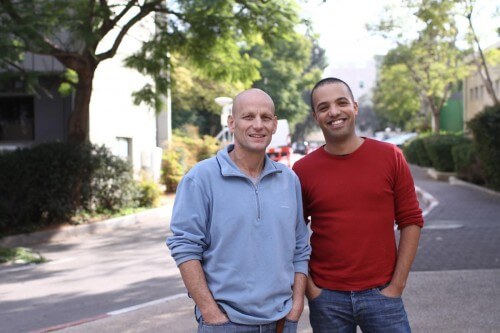About one in every 4,000 babies suffers from DiGeorge syndrome, a congenital syndrome that causes a series of abnormal symptoms, mainly in the face and heart

About one in every 4,000 babies suffers from DiGeorge syndrome, a congenital syndrome that causes a series of abnormal phenomena, mainly in the face and heart. The syndrome is usually caused by missing a small piece of chromosome 22, but strangely, there is great variation in symptoms and their severity among those who suffer from it. The defects in the face, for example, can manifest in a cleft lip, difficulty eating, or slight weakness of the muscles near the mouth. The heart defects may include deformities in the septum that separates the ventricles, or an abnormal position of the aorta. Prof. Eldad Tzhor, and research student Itamar Harel, from the Department of Biological Control at the Weizmann Institute of Science, recently revealed new details about the complex genetic network that underlies the syndrome's development.
Prof. Tzhor studies the developmental relationship between the muscles of the face and the heart. He discovered that at a certain stage of early embryonic development it is possible to identify a defined population of cells from which the cells that will build parts of the heart, as well as cells that will give rise to the facial muscles, develop. These common progenitor cells are located in the mesoderm - an early embryonic tissue from which the heart, muscles, blood and skeleton develop. "You can say that the special group of cells that we discovered study together in the first grade, and when it ends, the cells move to separate classes and different study tracks," says Prof. Tzhor.
What are the essential genes for the normal development of the heart and facial muscles? Is more than one gardener involved in the process, and if so, how is the work divided between the different gardens? Harel and Prof. Tzhor focused on the transcription factors: proteins that bind to DNA, and thus regulate the first step in protein production: the transcription of DNA into an RNA molecule. In an initial scan of the active transcription factors in young mesoderm cells (that is, "grade 2"), proteins were discovered, which are known to be related to the development of these cells, as well as another transcription factor called LhxXNUMX. It is known that this transcription factor is involved in other developmental processes, such as the development of eyes, blood cells and hair follicles, but it has never been identified as being involved in the development of the heart and facial muscles.
Later, the scientists examined the effect of the transcription factors on the development process of the fetus. They created genetically engineered mice, in each of which the gene responsible for one of the transcription factors found in the previous step was deleted. In other mice, pairs of transcription factors were knocked out. In mice in which a single gene was deleted, the scientists noticed various deformities in the heart and facial muscles - some subtle and some more severe - reminiscent of DiGeorge syndrome. However, in mice in which two genes were deleted, the cells were not able to "go to the second grade", so that different structures in the face and heart were not formed at all.
By combining these findings with other research approaches, the scientists created a model that describes the interrelationships between the various transcription factors. The model suggests that the activity of individual transcription factors is significantly less than the joint activity of the overall network. It seems that some of the elements of the network criticize each other's activity, through direct or indirect means - through other transcription factors. Prof. Tzhor believes that as a result, at least for some of the transcription factors, in the event of "negligence" or damage to their duties, it is possible to transfer the task to other transcription factors - so that the activity of the entire network is relatively stable. "Even if one of the factors is missing, the damage to the network's activity will be relatively small," he says. Since the network is involved in the construction and also in the fine tuning of structures in the heart and interior, abnormal activity of one of the transcription factors may cause an excess - or lack - of the genes it regulates, thereby throwing the entire mechanism out of balance. This can cause congenital heart defects - the most common group of defects in fetal development.
In addition to discovering the interrelationships that direct the development of the heart and the face, the findings, which were recently published in the journal of the US National Science Association (PNAS), may also help in medical research, because they contribute to understanding the relationship between various heart and face defects that characterize those suffering from the syndrome D-George. For example, in some cases mild facial muscle deformities may be associated with more serious heart defects. A better understanding of the relationship between these phenomena may have medical applications.
Itamar Harel points out that the picture is still not fully clear. For example, few people with D-George syndrome do not have any chromosomal defect. This fact leads scientists to believe that additional genes are involved in the development of the syndrome in humans, which are not found on chromosome 22. The model based on the research in mice also supports this possibility. Recently, a large-scale project was launched, designed to identify additional genes in the entire human genome. In it, scientists compare the genomes of healthy people with those of people who suffer from DiGeorge syndrome but whose chromosome 22 is normal, with the aim of identifying additional genetic factors that may be involved in the syndrome.
